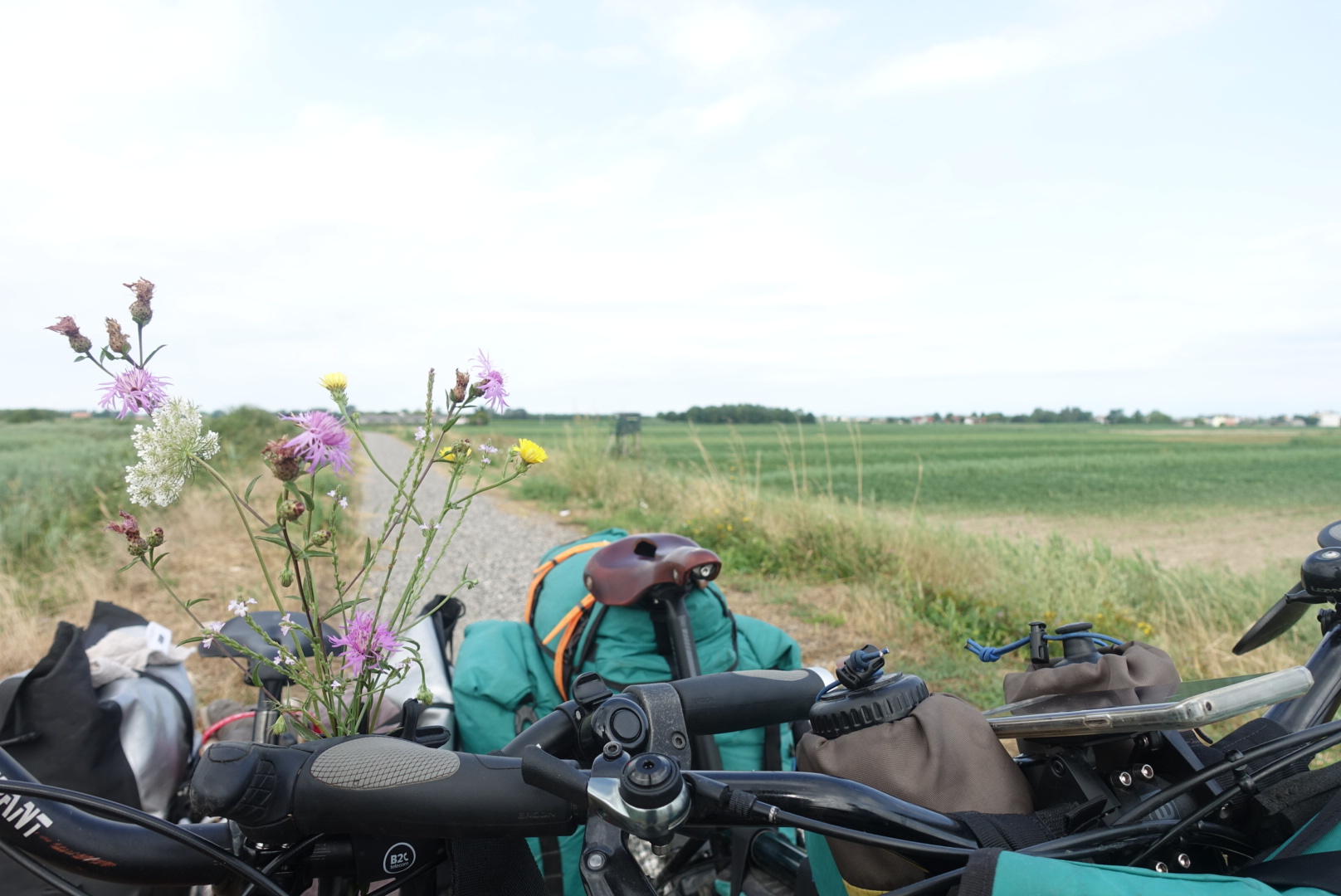Venezia
Our plans were to head to the trainstation in Ferrara, buy some tickets to Adria, and to cycle the Venezian peninsula from south to north. Naturally plans always seem to change on a bike: the regional trains would not take our bikes further than Padova. A quick scan of the map under the assumption that big cities would not be served by regional trains led us to decide that we would take the train to mainland Venezia, namely Venezia Mestre.
There we exited the train in the Italian summer heat, and made our way to the bridge that would bring us to Venezia. Cycling over that bridge was a great experience. You see small islands everywhere, some with special buildings on them, others apparently considered too small by history for buildings, hence covered with trees and shrubs. As you continue you see the various boats, some private, some serving as public transport, criss-crossing around eachother to reach their next stations, and have the historic buildings of Venice slowly approaching as you cycle onwards. Having crossed the bridge we took our bikes to the nearest park to relax in the shade and have something to eat. We got told by a local, upon having just decided to carry our bikes all the way to the San Marco square, that bicycles are illegal in Venice. So we exited the city proper towards its main port, and went to Lido di Venezia to get to a nice campground that wasn't too touristic. It had a nice, nonsubdivided field for our tent, and the luxury of a shared fridge.
After a quick look at the adriatic sea that evening we decided to split up the next day. I would spend my day visiting the city of Venice (never having been there), and my special friend would spend the day cycling up and down the stretches of land enclosing the lagune. That afternoon I told of my random walk through the alleyways of Venezia. I experienced the buzzing of tourists in the main streets, with mostly deserted streets around that relatively small center of Venice. You can see some of the locals expertly weaving in and out of alleyways when they consider particular sections of the maze that is Venice to be too crowded. I attempted to do so myself without a map, but kept walking into dead ends, or missing bridges that I needed to cross to keep heading towards the park on the eastern side of the island. Altough slightly hesitant to enter the most touristic of sights, I couldn't leave Venice without having seen San Marco's square. It is an immense square with every building ornated with meticulous detail. I can't begin to describe, or even try to paint a mental picture, of the immense complexity of the main attrection: San Marco's basilica.
My girlfriend's journey led her past the beaches, and most interestingly the various kinds of beachhuts the locals have created using driftwood and cloth, some adorned by their owner's names.
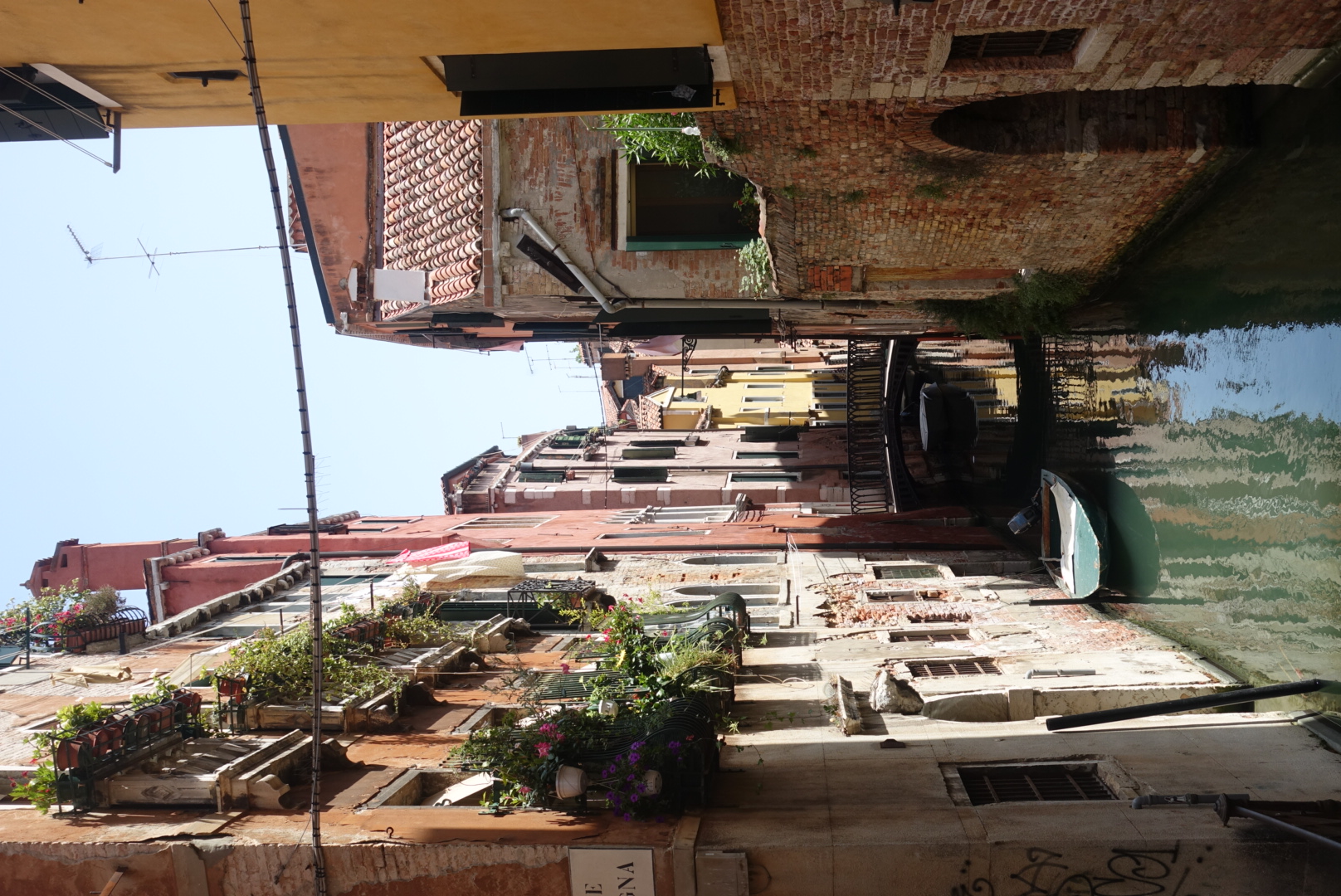
I've heard of stories that Venice has become a place that is no longer a living city, rather an open-air museum. Although I did see some graffiti attesting to the disgruntlement of at least one vandal with the city's evolution (it read "squat bnbs", with next to it a circle and inscribed zigzagging arrow, the squatter's symbol). I cannot attest to these stories' truth, as we've been visiting these parts of Italy during a heatwave; am I seeing deserted streets, or am I witnessing Italians wisely hiding themselves inside during the middle of the day? To my fellow bicycle tourists I can say that it is at worth a visit, even for a day, even if you skip the city centre altogether. My advice would be to just travel along the beaches, taking ferries towards Lido. There you'll find a very nice small camping among the megacampings surrounding it. You can spend a day in Venice by buying a pretty expensive 24-hour waterbus-ticket of 25 euros. Be wary that there are ferries of various sizes, the largest ones will always take your bicycle (but the one between Lido and Punta Sabbioni only goes on monday and friday as of July 2023), the smaller ones will officially not take your bicycle. Unofficially, as long as you do not take a ferry that is heading into Venice or that is already crowded, you'll be able to take your bicycles to the next island/peninsula on one of these smaller ferries (we figured this out after being sent back and forth between the bigger and the smaller ferries, finally asking a barowner and hearing him say in a reassuring tone "ah, bicycle no problem, car is problem"). You can also take the bridge from the mainland, but you'll have to pay for the ferry from Venezia to Lido di Venezia as well.
Promises of Beaches
As you'll find out whenever you're traveling by bike (in certain countries) close to the sea or a big lake: it will be subsumed by the rich or by tourism. Your view will be blocked by walls and hedges neatly signposted in the local language telling you that access is forbidden. It always makes me appreciate the way the Netherlands have most of of the beaches publically accessible.
Our little journey northeastward of Venezia was the same: farmland to the left of us, and megacampings to the right. Although I'm deliberately being too cynical here: everwhere we've been along the Veneto coast we've found "free beaches", some marketing genius decided that "paid beaches" would be too honest, so I had a chuckle at the alternative: "service beaches". When we got close to Caorle, we decided we would go for a dip in the Adriatic sea, and enjoyed a little siesta in a park inbetween the campings.
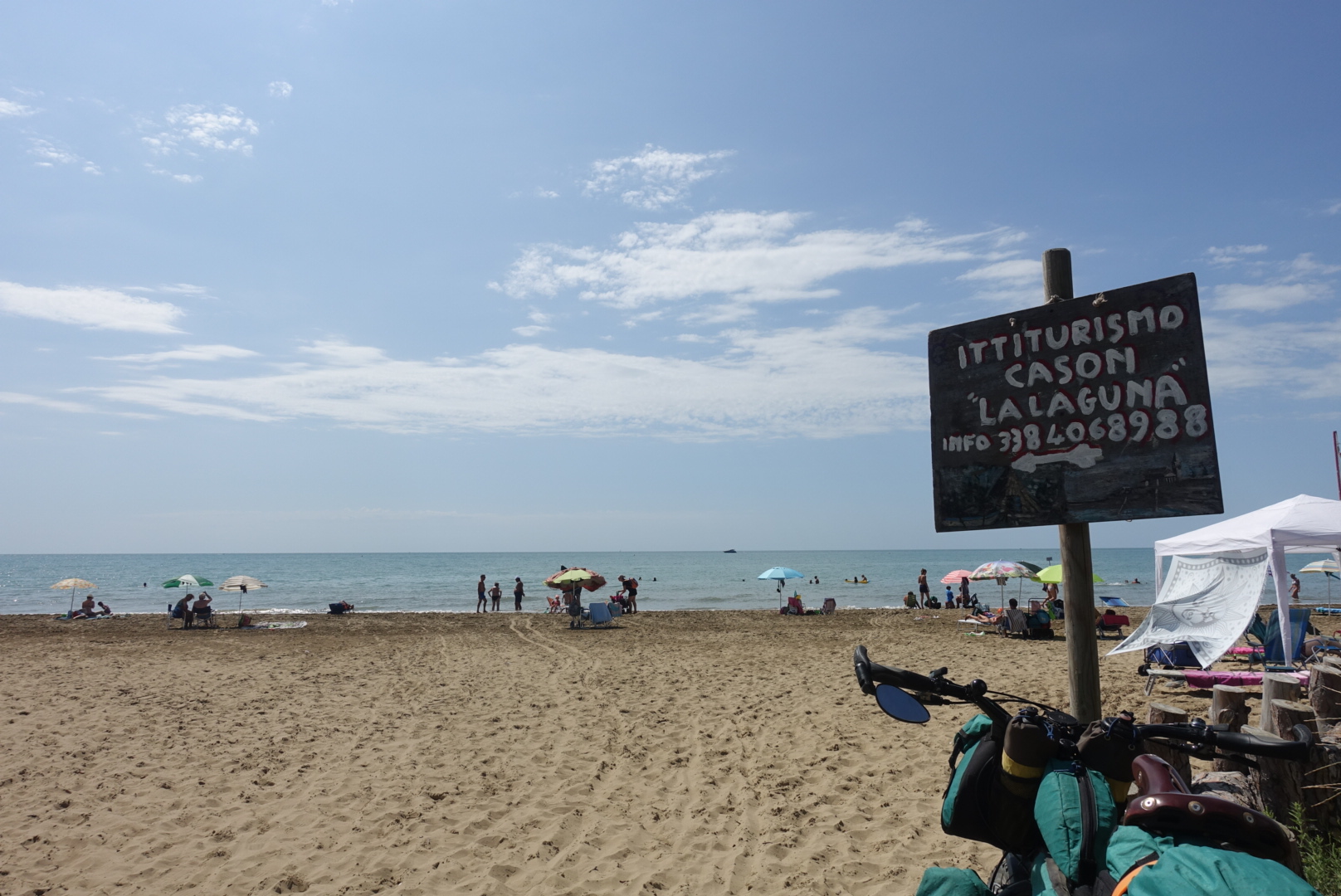
Our interpretation of our map led us to believe that nearby Caorle there would be a perfect place to camp on the beach. In order to reach said beach we would only have to take a ferry that, according to a set of pictures we found online, departed at 17:45. Upon arriving at the specified pier at 17:15 we learned that the boat had an alternative schedule these days: we missed the last one at 16:00, and it wasn't likely we would find an alternative spot to wildcamp nearby.
We asked a group of nearby Italians, sitting in their front yard, in our best Italian (which currently mostly consists of a toddler's vocabulary) if there were any boats to our intended destination. Upon learning there were none we asked: "sleeping? here?", making a gesture as to indicate we were looking for a place nearby. A (quite manly) man asked, without the slightest hint of emotion: "tent?", and upon hearing us answering in the affirmative he pointed to a shaded patch of grass beneath a tree in the front yard, said "ok", and turned around to walk back to his chair.
We were pretty happy with the offer, being able to sleep so close to the pier to catch the boat the next morning, and slightly confused by the man who would not react to our expressions of gratitude, even when walking out later to offer our bikes shelter from the rain, and to offer us water from the fountain outside the house.
That evening and into the night an impressive thunderstorm passed overhead, with continuous flashes of lightning temporarily illuminating individual clouds among the seemingly singular black mass that was the sky. There was a lot of lightning, but only occasionally did we see a bolt of lightning connect with the ground. Luckily we were spared a downpour, only having a couple of drops of rain landing on our tent. This marked the beginning of our luck with the weather.
Through the Lagune
The next day we could take our intended ferry to Vallevechia. We made a short detour to the beach to jump into the adriatic sea one more time. Due to the ferry's timetable we spent most of our cycling later on that day in the sun, not a terribly wise decision, and additionally along relatively boring farmland. But it wasn't without any joy: we were able to pluck some apples straight from a tree, something I have never done before (I'm always afraid of accidentally poisoning myself). At the end of the day, we found that our expected wildcamping spot turned out to be a fluke. But the cyclotourist's road will provide: after resorting to go to the nearest camping, we found a ruined building only a kilometer down the road (there are a lot of them in the Italian countryside). Which prompted my girlfriend to ask: "what about camping here?". It was a nice and secluded place among trees and grass (and a giant ruined building of course).
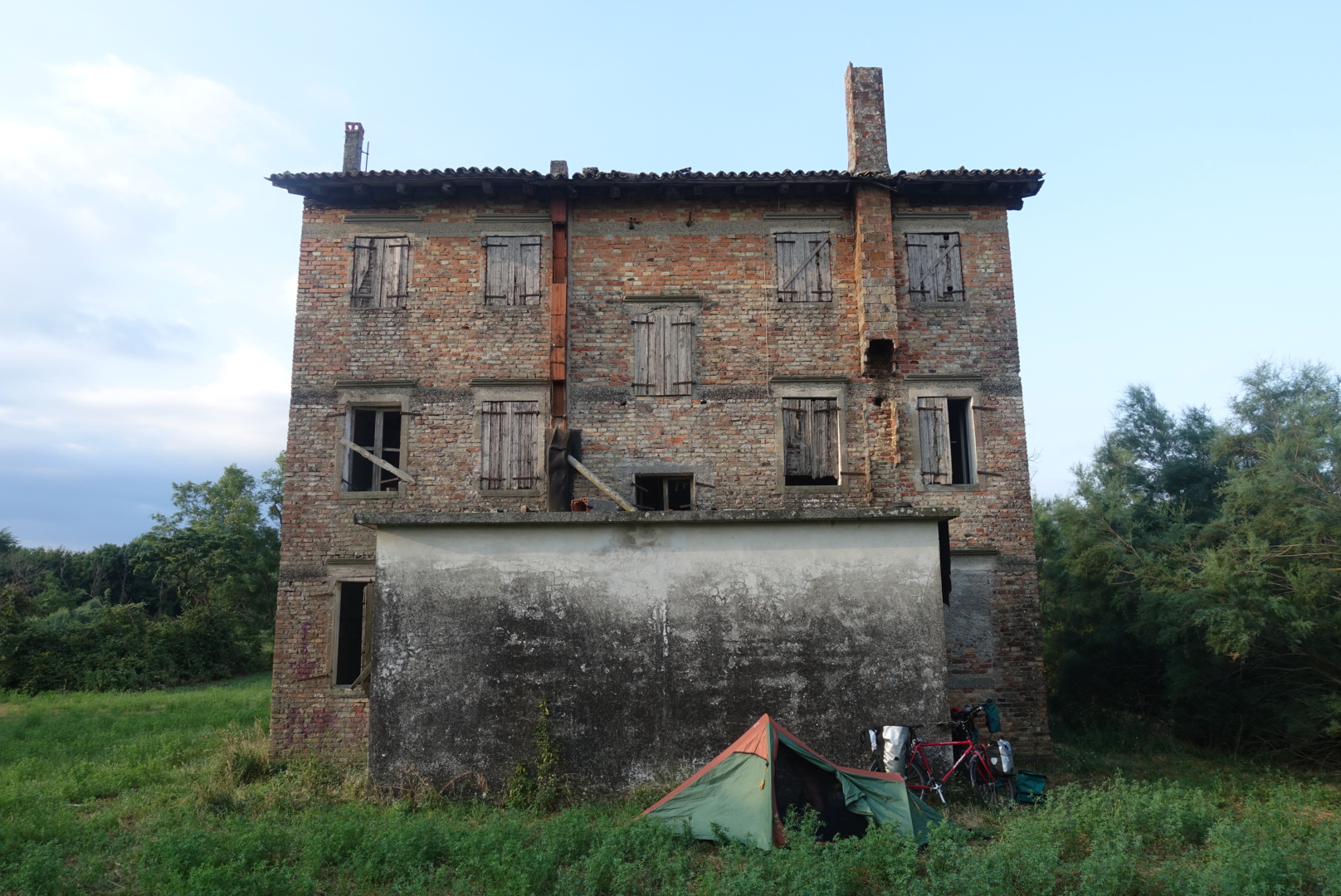
The next morning was overcast, bringing the first day that had a truly enjoyable warmth to it. We noticed that the landscape started to change: the Alps were once more clearly visible to the north, and amongst the fields of corn and rice we started seeing vineyards. And instead of all this farmland being segregated by little drainage canals, we would find small patches of trees in their stead. Everything simply seemed more green. The simplest way on a bike to detect changes to a culture, or to find the historical borders of countries, is to look at the religious buildings. And indeed the curches in Friuli started to look different to the ones we saw before, likewise we could see that signs carrying the names of villages were written in two languages (that, or it is a dialect, we don't know).
We passed by another lagune, specifically the reserve "Foci dello Stella", where we saw a large number of birds unfamiliar to us. Among them (we're 99 percent certain) we saw flamingos, the first we've seen with our own eyes.
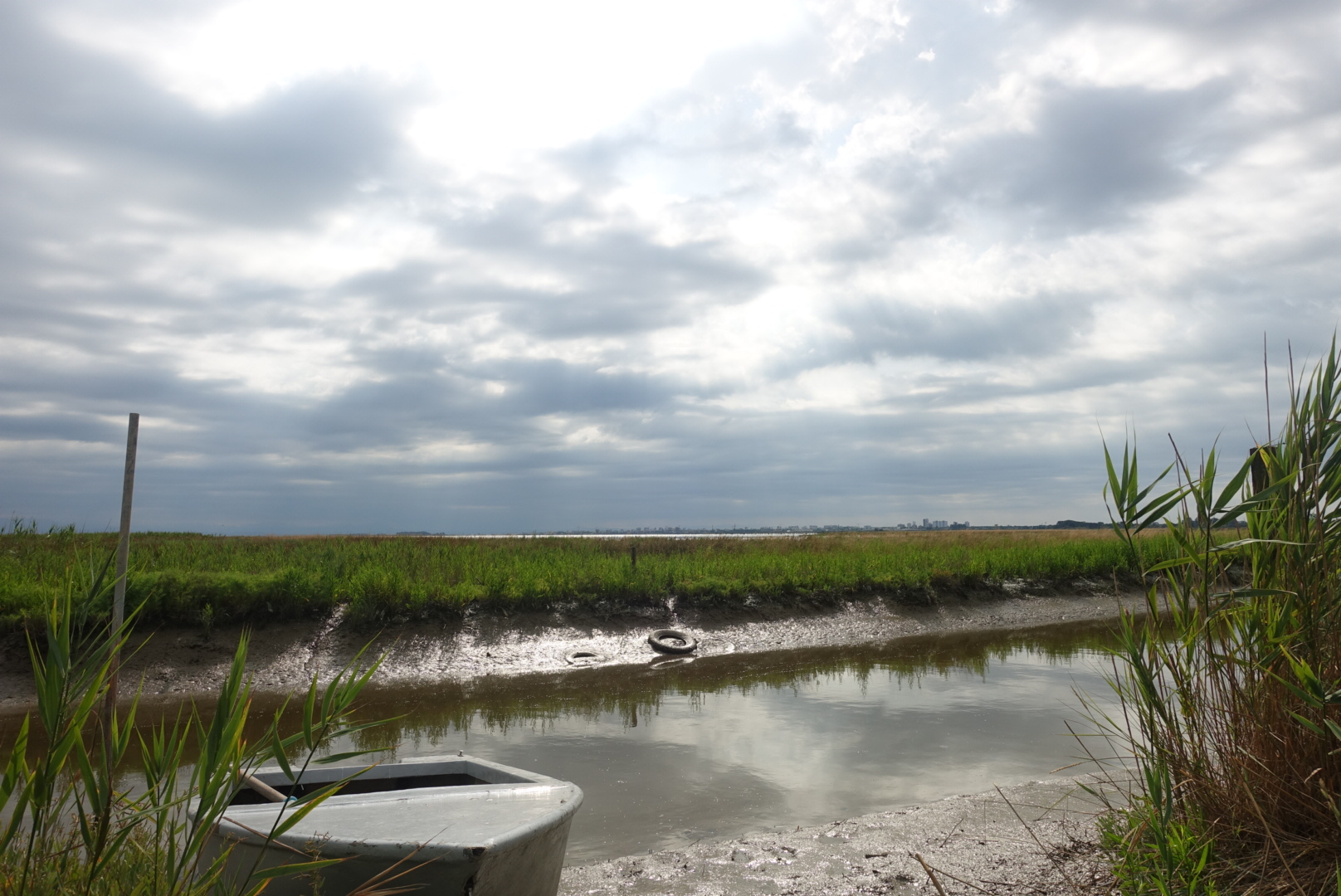
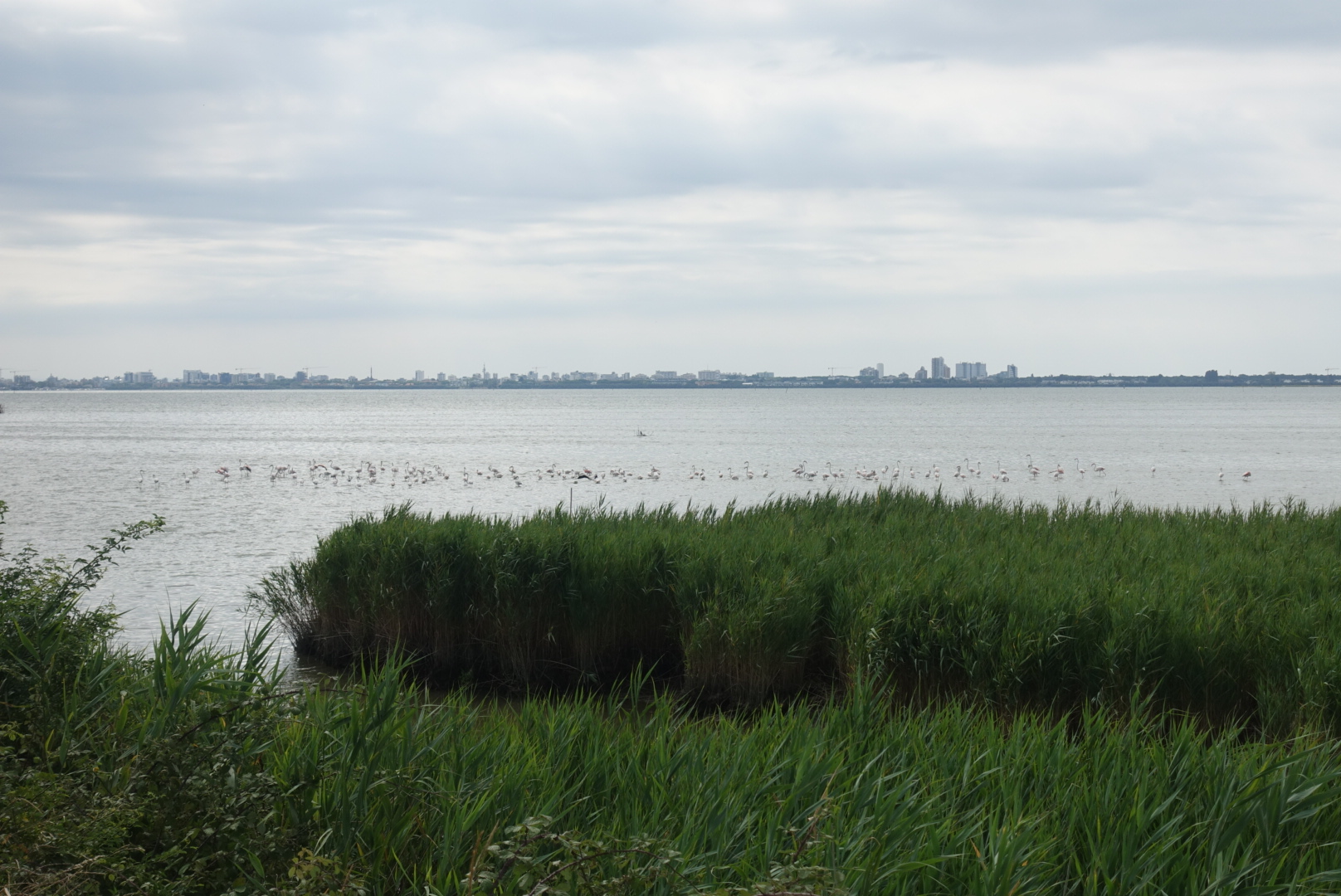
We would have even more luck with the weather. As we passed through San Giorgio di Nogaro it started to rain. We spent the end of the day buying ourselves dinner, and discussed whether we would cycle the last couple of kilometers and set up the tent in the rain, or wait it out. In the end we decided to go to a nearby microbrewery, just because it was nearer to us than any cafes, and it was in our route. A pedalstroke or five later we were there. It seemed closed, just somebody's house with an attached workplace. We were planning on turning around when somebody busy renovating one of the buildings gestured to come over and said they were open. It was a family business, and as we walked over to the direction in which the man gestured, the mother and son came out of the house to open the brewing area of Aganis Beer just for us!
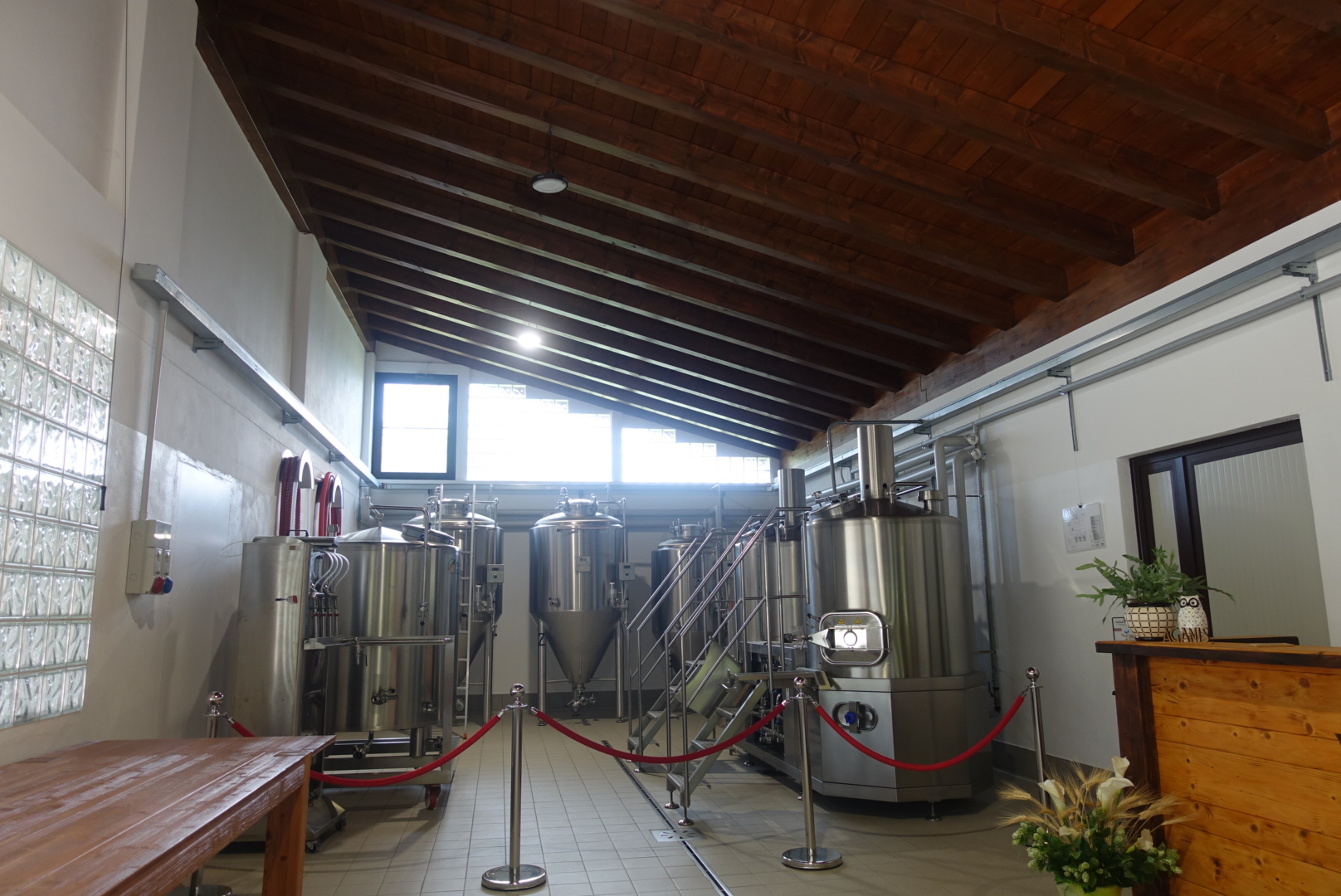
We ordered two beers, and explained that we found their brewery as we were using google maps to find a place to shelter from the rain for an hour. I suppose it took 15 minutes until the rain turned into a massive downpour, making us rather happy we did not decide to trudge onwards and set up our tent in the rain. We were explained that although the weather this close to the mountains is always unpredictable, the way it had been behaving for the past couple of years is very different from what the parents were used to. They even had an exceptionally intense storm recently where the wind destroyed a lot of the buildings and trees. This explained the large number of downed trees and even flattened sections of vineyards we saw cycling that day. They suspected it was caused by climate change.
The son also told us about the reason behind there being so many ruins in the Italian countryside. These are all very old buildings that mostly end up being inherited. One would think that one can transform these historical buildings into homes, but a plethora of Italian laws regarding construction (necessary or not, we do not know) make it more expensive to renovate than to completely rebuild. As a result these buildings litter the landscape, sometimes with a couple of sunbleached "vendesi" signs scattered over the property.
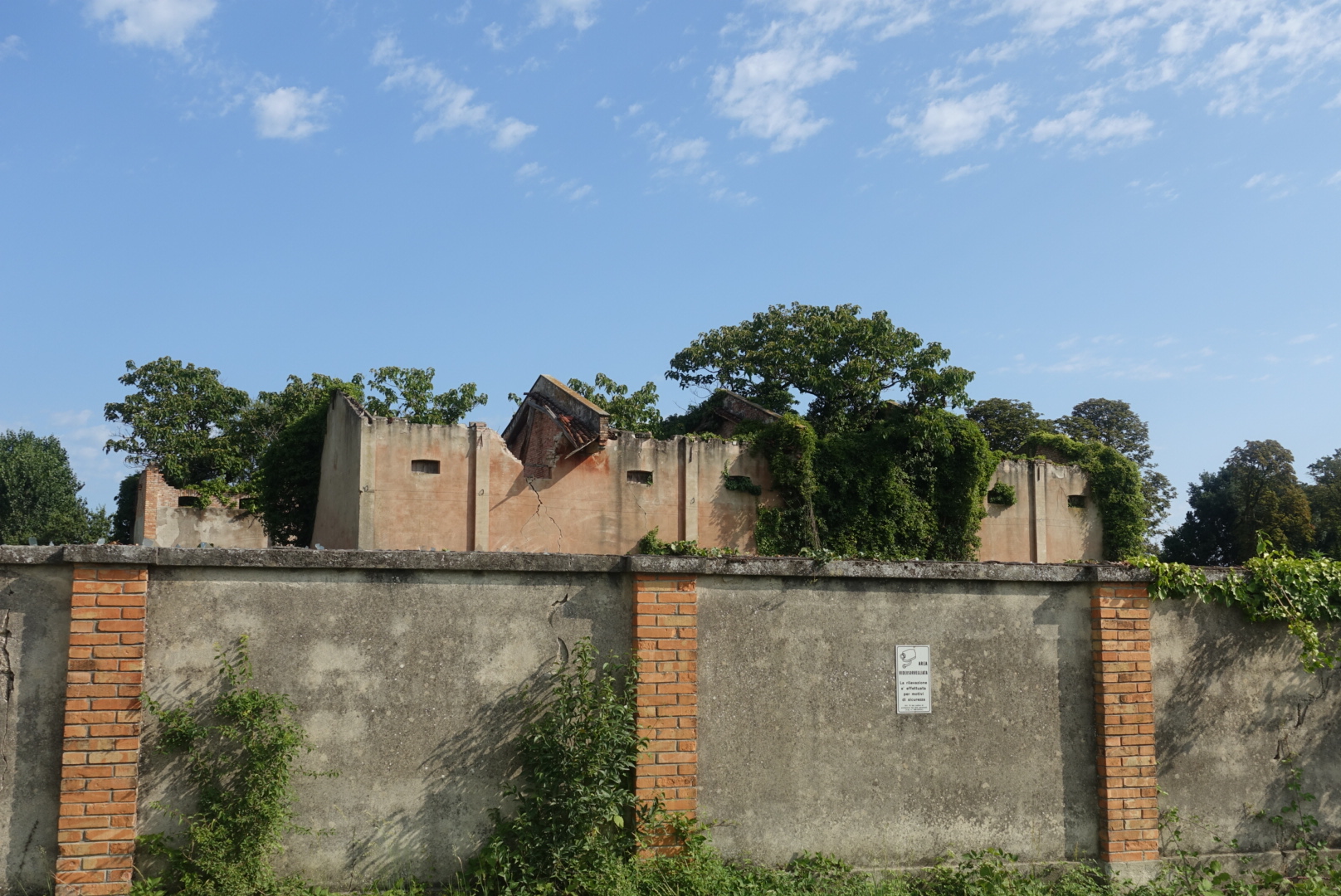
As we drank our beers, and the weather outside started to calm down, we got a tour of their brewery and the son explained their brewing process to us. We talked of their company, our trip, and their life in general until our beers were finished, and our legs were aching to get to our camping spot for the night. A couple of kilometers later, after looking for an hour for a nice place, we found one in the shade of some trees overlooking a recently sown field next to a section reserved for the wild growth of native plants. After sitting outside for a while and having our dinner, the inevitable swarm of mosquitos came out to have dinner of their own, so we hurried into our already prepared tent to read and eventually fall asleep.
We woke up relatively early the next morning in order to cycle a short stretch to the next camping, our plan being to take a couple days of rest. Once again lady luck was on our side as halfway towards the camping, on a little detour we took to the main square of Cervignano del Friuli, we happened to stumble upon a small group of market stalls. And as we walked along the square's edge, after having our espresso in one of the bars, we were able to pick up fruits, vegetables, bread, and cheeses all produced locally.
We'll spend a couple of days at a camping in Acquileia. We'll regrease the chains (we had a little mishap next to a cornfield with some mud with the consistency of peanutbutter), get some rest, and plan the route for the coming days (we met some Americans going westward who told us of cycling the Parenzana route in the Istrian peninsula, which we were happy to discover through their stories as it seems like a good alternative to cycling its touristic coast).
